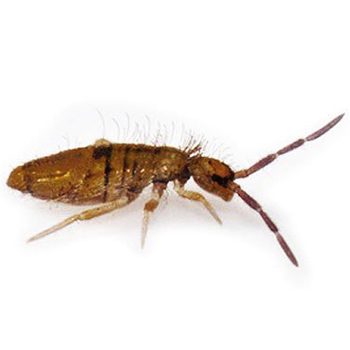Springtails

Keeping your property in New Jersey, Pennsylvania, Maryland, and Delaware free from the effects of pests is a crucial component of owning a home or a business. Regardless of the nature of the pests—whether they strike indoors or outdoors—maintaining the safety and condition of your property, as well as those who live and work throughout, should be of prime importance. Some pests don’t pose a significant health risk but are problematic nonetheless. Exterminators explain springtails may not cause infection or destroy your home or building, but they can be an irritant and hurt the value of your home or business, particularly from the perspectives of visitors, customers, or potential buyers. To protect your home or business from springtails, you need to learn about the behavior of this pest, take steps for prevention, and find effective treatment options should an infestation occur.
What Are Springtails?
Pest control experts explain springtails are minuscule insects that love moisture both inside and outside a home or business. Although they prefer to live outdoors, because they like damp conditions, you may find them in a basement, kitchen, or bathroom. Outside, springtails gravitate toward gardens, underneath mulch, or in flower beds. This is where they find their favorite foods: fungi, algae, pollen, and organic matter as it decays. In New Jersey, Pennsylvania, Maryland, and Delaware, springtails are more likely to appear in the months of April through October as they take advantage of the warm, moist conditions suited for damp and decaying habitats.
Springtails don’t have wings, but if you startle springtails in the house or office, they react by jumping—or “springing”—in the air. Pest control experts explain the springing action occurs when an appendage, known as a furcula, suddenly fills with fluid and then extends underneath the springtail, striking the ground and propelling it into the air. Because springtails often move in swarms, this may create a cloud-like formation several inches above the ground.
How Do I Identify Springtails?
Springtails are very small, about one or two millimeters long when mature. Springtails don’t have mouths on the outside of their bodies for chewing, so you won’t see any mastication mechanism on their heads as you see with ants, termites, and other common insects.
Exterminators state springtails like to cluster together and their sudden leaps into the air help distinguish them from other pests. Springtails are usually a variety of shades of brown, but can also be gray, white, or black. If you think you may have an infestation and don’t know how to get rid of springtails in your New Jersey, Pennsylvania, Maryland or Delaware home or business, consult with the pest control experts at Viking Pest for springtail extermination advice and services.
How Do I Get Springtails?
Springtails need a moist habitat, so if the outside environment is dry, they’ll move into your home or building in New Jersey, Maryland, Pennsylvania, or Delaware, if it has damp areas or a higher level of humidity. Pest control experts explain springtails tend to come into your home or place of business by squeezing through window screens or slipping through open windows and doors. Springtails can also enter through vent pipes or hitch a ride on a potted plant. Light attracts these pests, so if a window or door is open and the lights are on, they may be more likely to come inside.
What Are the Effects of Springtails in and Around My Home or Business?
Springtails don’t create a lot of damage, but they like to feed on the roots of plants. This stunts your plants’ growth. Springtails may also cause the leaves of plants to get a yellowish color. As nuisance pests, springtails form large swarms that inhabit your home or place of business. Exterminators state some swarms can be as dense as 50,000 springtails in just one cubic foot. An extermination expert can examine your plants and other areas of your business or home to see if they are being affected by springtails and make recommendations to fix the pest problem.
How Long Do Springtails Live?
Springtails can live for up to one year. During that time, these small insects can reproduce rapidly, and they also molt up to 50 times throughout their life cycle.
How Do I Prevent Springtails?
Because springtails love moisture, pest control experts recommend keeping your home or business in New Jersey, Pennsylvania, Maryland or Delaware dry as this makes it a less-likely destination for springtails. If you see a leak, you should get it fixed as soon as possible. If your basement in your home or business is prone to flooding, you should have a professional address the causes and fix the problem.
It’s also helpful to put some distance between your home or building and the natural outdoor habitats of springtails. For example, if you keep grass, leaves, and other plant matter away from your foundation, you’ll make a springtail infestation less likely to occur. The pest control experts at Viking Pest also recommend filling in cracks in the foundation and the areas around doors and windows of your home or business.















